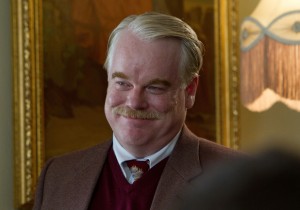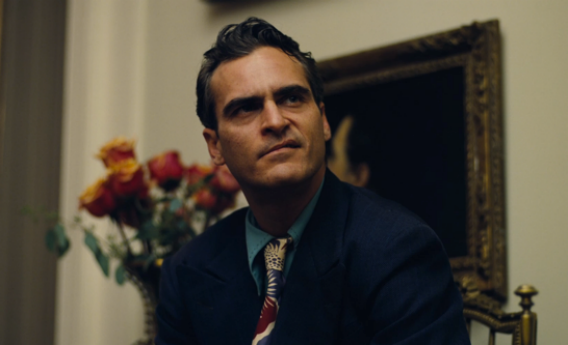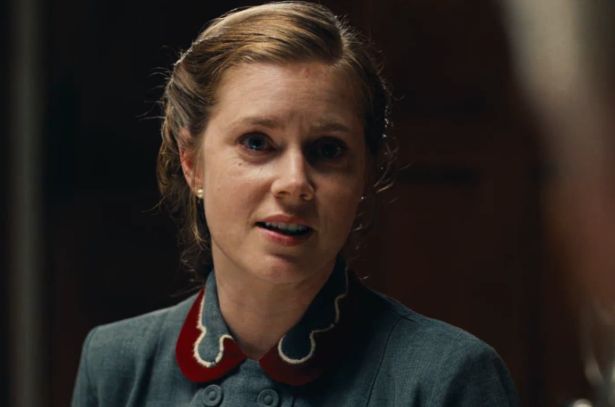Film Commentary: Submitting to “The Master”
Director Paul Thomas Anderson doesn’t provide answers nor does he pose questions: the ambiguity of his characters and his confounding storytelling style are what drive The Master.
By Tim Jackson.
Paul Thomas Anderson’s The Master is a hypnotic study of control and manipulation and possibly a love story, but one that evokes the emptiness and quackery at the dark heart of America. The film is built around a simple premise: an emotionally damaged, itinerant, alcoholic sailor named Freddie Quell (Joaquin Phoenix) crashes a party aboard a yacht hosting the wedding of the daughter of Lancaster Dodd, the leader of burgeoning cult named The Cause. Dodd takes a shine to Freddie, perhaps challenged by his possibilities as a “noble savage” to be tamed, but a closer viewing reveals a deeper connection for Dodd. “I’ve seen you before,” he says. “I know you.” He sets out to tame Freddie’s base nature and to train and condition him by way of the methods of The Cause.
Much has been made of the fact that Anderson is riffing on America’s vulnerability to cults. In our short history, we’ve certainly had our share of weird religions and wacky causes. In 1823 Joseph Smith was visited by the angel Moroni:
He called me by name and said unto me that he was a messenger . . . that his name was Moroni; . . . my name should be had for good and evil among all nations, kindreds, and tongues, or that it should be both good and evil spoken of among all people.
Earlier in the twentieth century, Aimee Semple Macpherson and her Foursquare Gospel Church drew massive crowds and controversy with radio evangelism and elaborate stage spectacles (she can still be seen on YouTube speechifying about prohibition). Spiritualism thrived at the turn of the twentieth century. The First Spiritualist Temple built in 1885 (which became the Exeter Street Theater) was designed by none other than H. H. Richardson and still stands at the corner of Newbury and Exeter Streets in Boston. Dr. John Harvey Kellogg used the showmanship of a P. T. Barnum to amass a holistic health following, founding a groundbreaking sanitarium that focused on nutrition, enemas, and exercise, subsequently starting up a breakfast empire.
Boston had an interesting cult in the late ’60s led by musician Mel Lyman. The Lyman Family, also known as the Fort Hill Community, published a magazine they called The Avatar. Located on Fort Hill, the group claimed musician Jim Kweskin and other artists as followers. In 1971 Rolling Stone published a cover story exposé, and, in the shadow of the Manson tragedies, the troupe eventually dispersed.
From Mormonism and Scientology to dangerous fringe groups such as the People’s Temple, what in the American character is so vulnerable to cults and self-appointed leaders? Is this need an elemental part of human nature, or have these cults manufactured unique ways to combine spiritual need and free enterprise? What differentiates a mass self-help enterprise from a cult or a religion? Anderson doesn’t provide answers nor does he pose questions: the ambiguity of his characters and his confounding storytelling style are what drive The Master.
To begin with, the attraction between Lancaster Dodd and Freddie Quell has been seen by some critics as an id/ego paradigm, by others as a father/son bond or a homoerotic attraction. (Intriguingly, Anderson himself has called his film a “love story.”) These are all legitimate interpretations. The director has created such knotty relationships before, from Burt Reynolds’s porn film guru in Boogie Nights to the dysfunctional and ultimately lethal bonds of both family and religion in There Will Be Blood. In that film, Daniel Day Lewis’s mad oil baron Daniel Plainview embodies capitalism gone amuck. Greed trumps religion when, as an act of ultimate revenge, Plainview coerces Paul Dano’s evangelist Eli Sunday into confessing “I am a false prophet; God is a superstition” before pummeling him to death with a bowling pin. Having condemned the corruption and damage carried out in the name of free enterprise and evangelism, the director now sets his sights on a more personal yet elusive target.
While the audience tries to decipher clues to the meaning of Quell’s obsessive behavior, Dodd’s glib speeches, and the questionable practices of cult indoctrination, there is another possibility—both characters are madmen. When Dodd says to Quell, “I’ve seen you before. I know you,” he isn’t being figurative, he means this literally. The Cause is built on behavioral therapy and past life regression. There is every indication that Dodd believes he is in the presence of a comrade from a past life. (The book Many Lives Many Masters contains striking similarities to what Dodd suggests.) Without giving away a plot point, listen carefully to the last scene between the two men; it will send chills up your spine. To Dodd’s left in this scene sits the core strength of The Cause, Peggy Dodd. Portrayed by Amy Adams with a sweetness, charm, grit, and determination that has become her signature gift as an actress, Peggy, like Lady Macbeth, anchors her husband to reality while boosting his confidence. She cajoles, soothes, convinces, commands, and in one distressing scene, even masturbates her disturbed husband. Still, it is Lancaster whose charisma and tenacity have built this questionable empire.
And what of Quell? Whose story is this really? The aptly named Quell has some serious demons but none of the complexity of Lancaster Dodd. He is beyond being a mere alcoholic. While he may be a damaged veteran, an apt symbol of war’s long history of shell shock or PTSD, he also comes from an alcoholic father and an institutionalized mother. The concoctions he drinks made of alcohol mixed with photo chemicals, boat fuel, paint thinner, or whatever else he can find reduces him to a feral state. He understands three things: work, fight, and fuck. Still, Dodd continues to try to condition Freddie via the cult’s behavioral training methods, bringing him to parties as if he were a pet, as well as a pet project. Is he Dodd’s alter ego, his greatest challenge, the Galatea to Dodd’s Pygmalion?
One metaphor for their relationship that Anderson must intend, and it borders on comical, is that they are master and dog. Freddie is nothing more—in reality—than a junkyard dog protecting his master. At a party of followers, when a man calls Dodd to task on his “science,” Freddie throws food at the doubter. Dodd yells at him: “Freddie, NO.” He might as well be saying “down boy.” Often we see Quell violently reacting to protect his Master from hostile actions or language. At one point, both men end up in adjoining jail cells, and Dodd, in desperation, finally tells Freddie, “Your fear of capture and imprisonment is an implant from many years ago.” Freddie’s reaction echoes the same words just heard from Dodd’s own discontented son: “You’re making this shit up.”
Freddie has no real idea what is going on. His instincts are basic. His interest in Dodd’s work is carnal and combative. Early in the film, Freddie wanders into a room where young women of The Cause are listening to aural conditioning tapes that repeat over and over “Man is not an animal. We are part of the natural kingdom. You are not ruled by your emotions. Do away with all emotional baggage. Man is not an animal.” Freddie listens uncomprehendingly, grins, and writes a note to one of the women—“Want to fuck?” She returns a bemused grin. This unsettling reference to Scientology’s efforts to reduce the barriers of the “reactive mind” toward a clear, natural state is farcical and, in Freddie’s case, foreboding.
Lancaster’s wife Peggy knows Quell is too damaged to be reconditioned but patiently endures his transgressions out of respect for her husband. It is most likely her idea to let Freddie off his leash, take him to the desert away from the walls where he has been trained to obediently walk back and forth in an effort to strip him of his ego, a typical cult method. They test him by letting him run free, to escape if he so chooses, or else to return like a well-trained canine.
Much has been said about the performances of the three lead performers. As he did with Daniel Day Lewis in There Will Be Blood and Adam Sandler in Punch Drunk Love, Anderson has pulled from his lead actors performances that are stunning in their naturalness and honesty. I mentioned Adams, who is used here for everything she does best—to charm, attract, and frighten all at once. Phillip Seymour, as Lancaster Dodd, is playful and in control, but his blushing pink skin and watery eyes belie a man seething with doubt and rage. Joaquin Phoenix’s acting is odd to the point of becoming downright disconcerting. According to interviews, he exaggerated an actual spinal problem to achieve Quell’s twisted hunch. His signature upper lip is transformed by both the camera and the actor into an exaggerated sneer stuck on one side of his face. His range of raw emotion, from mumbling incoherence to uncontrollable rage to feral coupling, makes us wonder about the depths from which the actor is drawing the performance.
The Master can best be described as impressionistic. Anderson is not only intentionally enigmatic about character motivation but disorienting with his use of music and plot details as well as subjective and objective points of view. Buoyed by an astonishing soundtrack by Jonny Greenwood, the film jags from one moment to the next without clear cause and effect. There are scenes where, without warning, we see things through Freddie’s eyes that are utter fantasy. Thrusting us unprepared into the mind of this poor, chemically deranged alcoholic has a deeper impact on the audience than if the perspective were clearly signaled to us. Our first reaction is confusion, then possibly amusement, and then questions about verisimilitude. Scenes play with our inevitable confusion about time, place, plot, character, and motivation. Anderson’s films frequently use vividly constructed yet unreal moments to taunt us. There is the shock of the SUV careening down an empty street and flipping over for no apparent reason in the beginning of Punk Drunk Love, or the rain of frogs in Magnolia, or Mark Wahlberg revealing his prized genitalia in Boogie Nights. These are not parts of conventional narrative as much as they are startling, dream-like moments.
As with certain films of director Stanley Kubrick, whom Anderson admires greatly, scenes are part of a larger vision, less concerned with plot than with creating a psychological effect. In Eyes Wide Shut, Kubrick subjects his audience to a numbing smorgasbord of sexual perversities and leisurely paced scenes, yet a single piano note hammers away throughout on the soundtrack. Kubrick knew that his audience would be fixated on the celebrity couple of Tom Cruise and Nicole Kidman, and he used this attraction to fashion a hypnotic meditation on desire, secrets, morality, reality, and fantasy. There are even critics who dig into the film’s occult symbols and hidden messages about “the new world order.”

PUNCH DRUNK LOVE — Paul Thomas Anderson’s lead actors performances give performances that are stunning in their naturalness and honesty
Regardless, I did find myself mildly depressed about an hour after the film, not because it wasn’t beautifully done, but it had so affected me on a deeper level. Kidman’s character could be speaking for Quell when at the end of the film she says, “I think we should be grateful, grateful that we’ve managed to survive through, all of our adventures, whether they were real or only a dream . . . and there is something we need to do as soon as possible.” “What’s that?” Cruise asks. Kidman responds, “Fuck.” Cut to black.
In Punch Drunk Love, Anderson also works at this subliminal level. Audiences called it an “Adam Sandler picture,” but it much more. Sandler, as Barry Egan, vanquishes his demons and enemies in his search for the pure love of Emily Watson. But the soundtrack and the use of light and color were the keys to the film. When I first saw it, as the credits came up I actually thought the movie was just getting started. What had happened? Where was the story? It took several viewings to see that the story was in these underlying details, in the intentional play of the colors red, white, and blue, the use of lens flair, the confusion of soundtrack and source music, the astounding performances by Sandler and Watson, and the expressionistic light designs of Jeremy Blake. (Ironically, Blake was preparing a suit against the Church of Scientology for harassment when he committed suicide in 2007). What I had felt watching Punch Drunk Love came only superficially from plot. What I felt was elation, love, hope, and the beginnings of romance.
Interpreting The Master is difficult. The evocative soundtrack, the wonderful cinematography of Mihia Malaimare shot in a rich, 1950s color palette, the artful use of California light, the luscious wooden interiors, all shot on increasingly rare 70mm film (the Coolidge Corner Theater projects it correctly in 70 mm) are at the service of a crush of ideas, themes, and award-winning performances that will provide some great discussions for years to come.
Tagged: Amy Adams, Joachim Phoenix, Paul Thomas Anderson, Philip Seymour Hoffman



